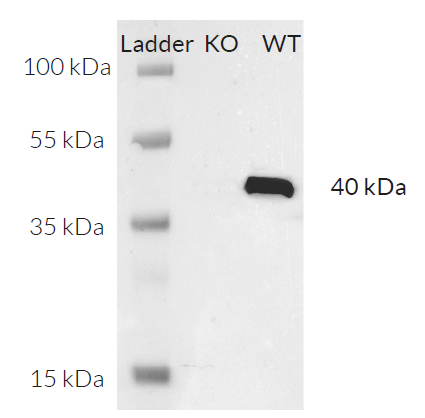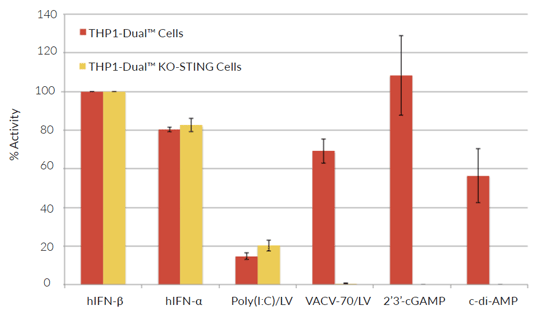THP1-Dual™ KO-STING Cells
| Product | Unit size | Cat. code | Docs. | Qty. | Price | |
|---|---|---|---|---|---|---|
|
THP1-Dual KO-STING Cells Human THP-1 Monocytes - STING knockout NF-κB-SEAP and IRF-Lucia Reporter Cells |
Show product |
3-7 x 10e6 cells |
thpd-kostg
|
|
||
|
THP1-Dual KO-STING vial Additional cell vial |
Show product |
3-7 x 10e6 cells |
thpd-kostg-av
|
Notification: Reference #thpd-kostg-av can only be ordered together with reference #thpd-kostg.
STING knockout dual reporter monocytes
THP1-Dual™ KO-STING cells were generated from THP1-Dual™ cells by stable knockout of the STING gene. STING (stimulator of interferon genes), alternatively known as MPYS, TMEM173, MITA, and ERIS is a direct sensor of cyclic dinucleotides (CDNs) [1-3]. These cell lines were derived from human THP‑1 monocytes, a cell line often used to study DNA sensing pathways as they express all the cytosolic DNA sensors identified so far (with the exception of DAI).
THP1-Dual™ and THP1-Dual™ KO-STING cells stably express two inducible secreted reporter genes: IFN-inducible Lucia luciferase and NF‑κB-inducible SEAP (secreted embryonic alkaline phosphatase). They can be used to study the role of STING by monitoring IRF-induced Lucia luciferase activity, using QUANTI‑Luc™ 4 Lucia/Gaussia, a Lucia and Gaussia luciferase detection reagent.
THP1-Dual™ KO-STING cells are resistant to the selectable markers blasticidin and Zeocin®.
References:
1. Burdette DL. et al., 2011. STING is a direct innate immune sensor of cyclic di-GMP. Nature. 478(7370):515-8.
2. Zhang X. et al., 2013. Cyclic GMP-AMP containing mixed phosphodiester linkages is an endogenous high-affinity ligand for STING. Mol Cell. 51(2):226-35.
3. Barber GN. et al., 2015. STING: infection, inflammation and cancer. Nat Rev Immunol. 15(12):760-70.
Specifications
Antibiotic resistance: Zeocin®, blasticidin
Growth medium: RPMI 1640, 2 mM L-glutamine, 25 mM HEPES, 10% heat-inactivated fetal bovine serum, 100 μg/ml Normocin™, Pen-Strep (100 U/ml-100 μg/ml)
Quality control:
Biallelic STING knockout is verified by functional assays, PCR, and DNA sequencing.
These cells are guaranteed mycoplasma-free.
Back to the topContents
- 1 vial of THP1-Dual™ KO-STING cells (3-7 x 106 cells) in freezing medium
- 1 ml of Normocin™ (50 mg/ml). Normocin™ is a formulation of three antibiotics active against mycoplasmas, bacteria and fungi.
- 1 ml of Zeocin® (100 mg/ml)
- 1 ml of Blasticidin (10 mg/ml)
- 1 tube of QUANTI-Luc™ 4 Reagent, a Lucia luciferase detection reagent (sufficient to prepare 25 ml)
- 1 ml of QB reagent and 1 ml of QB buffer (sufficient to prepare 100 ml of QUANTI-Blue™ Solution, a SEAP detection reagent)
![]() Shipped on dry ice (Europe, USA, Canada, and some areas in Asia)
Shipped on dry ice (Europe, USA, Canada, and some areas in Asia)
Description
THP1-Dual™ and THP1-Dual™ KO-STING cells stably express two inducible secreted reporter genes: Lucia luciferase and SEAP (secreted embryonic alkaline phosphatase). The Lucia luciferase reporter gene is under the control of an ISG54 (interferon-stimulated gene) minimal promoter in conjunction with five IFN-stimulated response elements. The SEAP gene is driven by an IFN-β minimal promoter fused to five copies of the NF‑κB response element. As a result, they allow the simultaneous study of the IFN regulatory factor (IRF) pathway, by assessing the activity of Lucia luciferase and the NF-κB pathway, by monitoring the activity of SEAP. Both reporter proteins are readily measurable in the cell culture supernatant when using QUANTI-Luc™ 4 Lucia/Gaussia, a Lucia and Gaussia luciferase detection reagent, and QUANTI-Blue™ Solution, a SEAP detection reagent.
THP1-Dual™ KO-STING and THP1-Dual™ cells can be used to study the role of STING by monitoring IRF-induced Lucia luciferase activity. Unlike the parental cells, THP1-Dual™ KO‑STING cells exhibit no detectable response to cytosolic DNA and CDNs while retaining the ability to respond to type I IFNs. As expected these cells remain responsive to RIG-I ligands such as transfected Poly(I:C).
Back to the top








